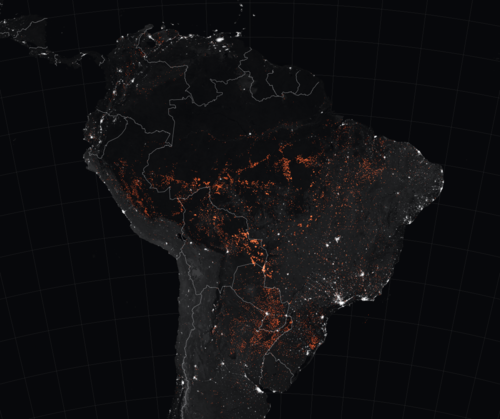| 2019 Amazon rainforest wildfires | |
|---|---|
Locations of fires, marked in orange, which were detected by MODIS from August 15 to 22, 2019 | |
| Date(s) | January–October 2019 |
| Location | Brazil, Bolivia, Peru, Paraguay, Colombia |
| Statistics | |
| Total fires | >40,000[1] |
| Burned area | 906,000 hectares (2,240,000 acres; 9,060 km2; 3,500 sq mi)[2] |
| Land use | Agricultural development |
| Impacts | |
| Deaths | 2[3] |
| Damage | >$900 billion (2019 USD)[4][5] |
| Ignition | |
| Cause | Slash-and-burn approach to deforest land for agriculture and effects of climate change and global warming due to unusually longer dry season and above average temperatures worldwide throughout 2019 |
| Map | |
 Amazon rainforest ecoregions as delineated by the WWF in white and the Amazon drainage basin in blue. | |
| Part of a series on the |
| Amazon rainforest |
|---|
 |
The 2019 Amazon rainforest wildfires season saw a year-to-year surge in fires occurring in the Amazon rainforest and Amazon biome within Brazil, Bolivia, Paraguay, and Peru during that year's Amazonian tropical dry season.[6] Fires normally occur around the dry season as slash-and-burn methods are used to clear the forest to make way for agriculture, livestock, logging, and mining, leading to deforestation of the Amazon rainforest. Such activity is generally illegal within these nations, but enforcement of environmental protection can be lax. The increased rates of fire counts in 2019 led to international concern about the fate of the Amazon rainforest, which is the world's largest terrestrial carbon dioxide sink and plays a significant role in mitigating global warming.
The increasing rates were first reported by Brazil's National Institute for Space Research (Instituto Nacional de Pesquisas Espaciais, INPE) in June and July 2019 through satellite monitoring systems, but international attention was drawn to the situation by August 2019 when NASA corroborated INPE's findings,[7] and smoke from the fires, visible from satellite imagery, darkened the city of São Paulo despite being thousands of kilometers from the Amazon. As of August 29, 2019[update], INPE reported more than 80,000 fires across all of Brazil, a 77% year-to-year increase for the same tracking period, with more than 40,000 in the Brazil's Legal Amazon (Amazônia Legal or BLA), which contains 60% of the Amazon. Similar year-to-year increases in fires were subsequently reported in Bolivia, Paraguay and Peru, with the 2019 fire counts within each nation of over 19,000, 11,000 and 6,700, respectively, as of August 29, 2019[update].[1] It is estimated that over 906 thousand hectares (2.24×106 acres; 9,060 km2; 3,500 sq mi) of forest within the Amazon biome has been lost to fires in 2019.[2] In addition to the impact on global climate, the fires created environmental concerns from the excess carbon dioxide (CO2) and carbon monoxide (CO) within the fires' emissions, potential impacts on the biodiversity of the Amazon, and threats to indigenous tribes that live within the forest. Ecologists estimated that the dieback from the Amazon rainforest due to the fires could cost Brazil US$957 billion to US$3.5 trillion over a 30-year period.[4]
The increased rate of fires in Brazil has raised the most concerns as international leaders, particularly French president Emmanuel Macron, and environmental non-government organizations (ENGOs) attributed these to Brazilian president Jair Bolsonaro's pro-business policies that had weakened environmental protections and have encouraged deforestation of the Amazon after he took office in January 2019. Bolsonaro initially remained ambivalent and rejected international calls to take action, asserting that the criticism was sensationalist. Following increased pressure at the 45th G7 summit and a threat to reject the pending European Union–Mercosur free trade agreement, Bolsonaro dispatched over 44,000 Brazilian troops and allocated funds to fight the fires, and later signed a decree to prevent such fires for a sixty-day period.
Other Amazonian countries have been affected by the wildfires in higher or lesser degree. The number of hectares of Bolivian rainforest affected by the wildfires were roughly equal to those of Brazil, being the area of Bolivia only about one-eighth of Brazil's. Bolivian president Evo Morales was similarly blamed for past policies that encouraged deforestation, Morales has also taken proactive measures to fight the fires and seek aid from other countries. At the G7 summit, Macron negotiated with the other nations to allocate US$22 million for emergency aid to the Amazonian countries affected by the fires.
- ^ a b "Situação atual - Programa Queimadas - INPE". queimadas.dgi.inpe.br. Archived from the original on June 20, 2022. Retrieved August 29, 2019.
- ^ a b "Brazil's Bolsonaro says he will accept aid to fight Amazon fires". CBS News. August 27, 2019. Retrieved August 30, 2019.
- ^ Moreira, Rinaldo; Valley, Jamari (August 15, 2019). "Casal morre abraçado ao tentar fugir de queimada em RO" [Couple die hugged while trying to escape burnt out RO]. G1 (in Portuguese). Archived from the original on August 15, 2019. Retrieved August 21, 2019.
- ^ a b Prabhjote Gill (January 6, 2020). "Amazon wildfires will cost Brazil trillions of dollars— damage from Australia's bushfires maybe 5 times greater". Business Insider. Retrieved September 10, 2020.
- ^ Rachel Tesler (August 26, 2019). "The cost of the Amazon wildfires". Yahoo Finance. Retrieved September 17, 2019.
- ^ Cite error: The named reference
BBC_20190821was invoked but never defined (see the help page). - ^ "Uptick in Amazon Fire Activity in 2019". www.earthobservatory.nasa.gov. August 23, 2019. Retrieved October 4, 2019.
